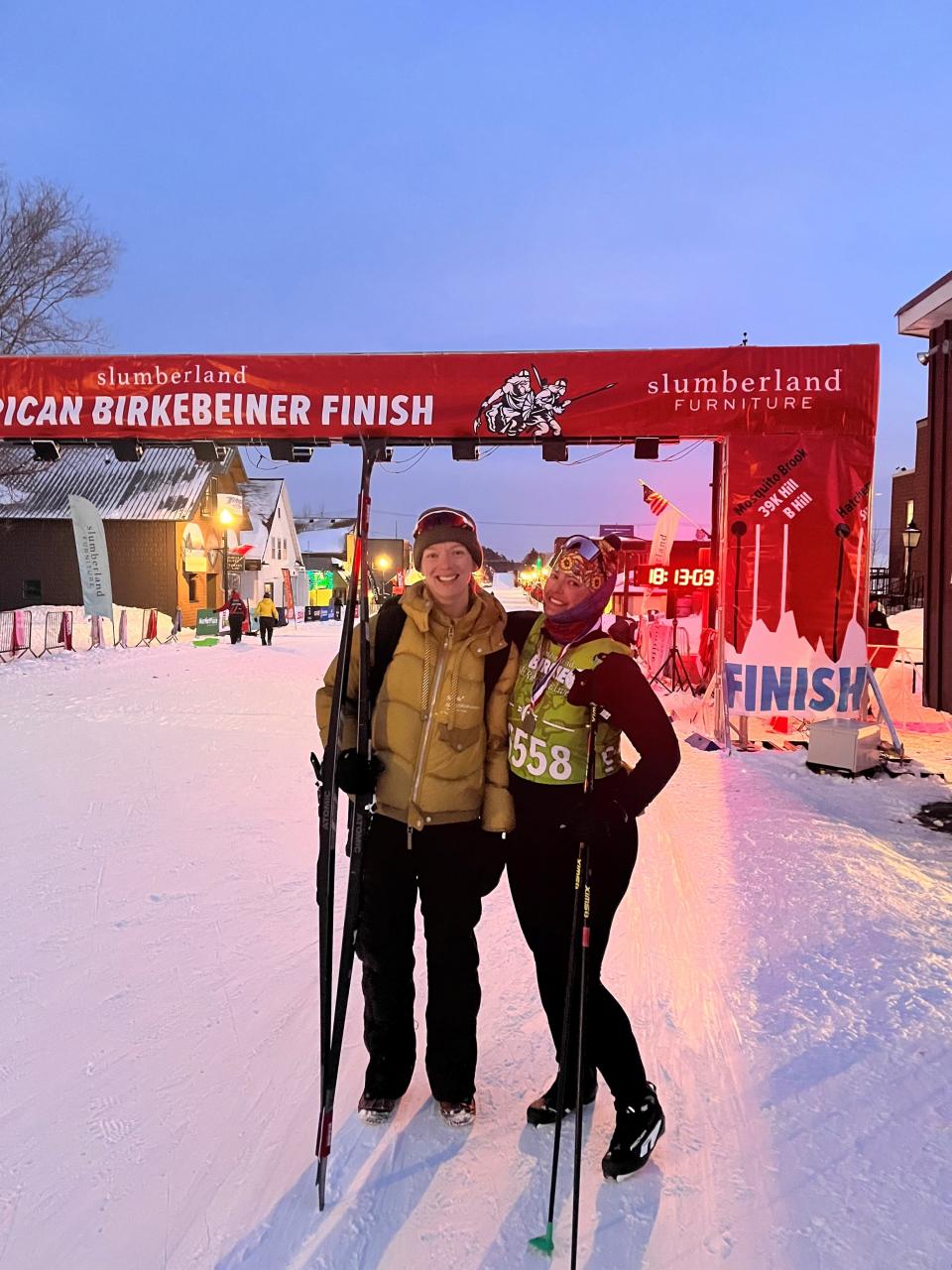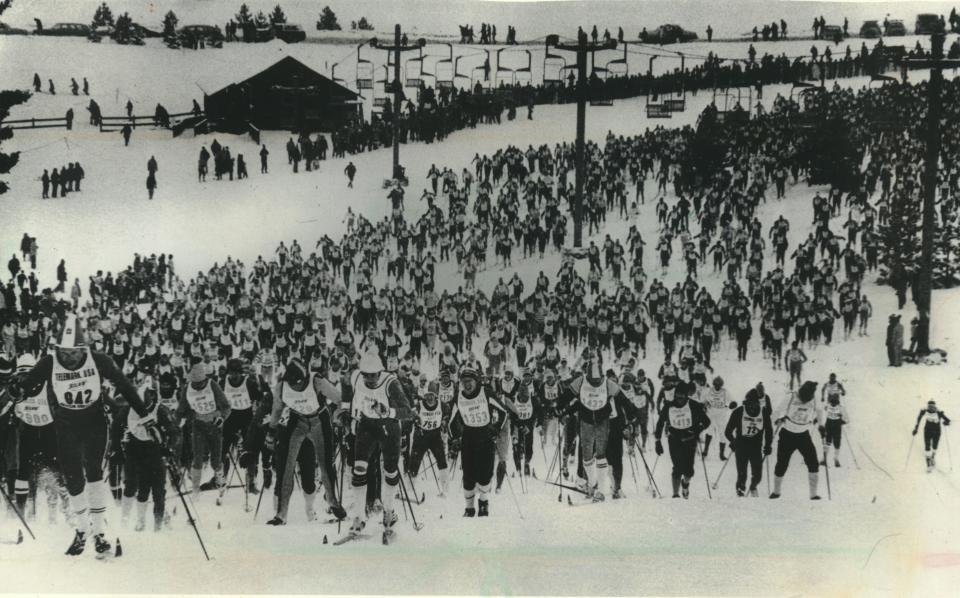She was last in her division in the 2023 Birkebeiner, but finishing the grueling ski race was still a triumph
Amber Glawe was confident in the plan she mapped out for the 2023 American Birkebeiner. Too bad the race didn't get the message.
The 38-year-old elementary school teacher from St. Paul, Minnesota, wasn't far into the 2023 race, skiing in the traditional, classic-style category, when she realized that the goals she had before the race were blowing away like puffs of breath on a cold winter day.
"I thought I was prepared," Glawe said. She had studied the course virtually and mapped out when she wanted to reach each aid station. But she had never been on the race course before, which runs 53 hilly kilometers (32 miles) between Mount Telemark east of Cable to downtown Hayward. As she skied along, minutes clicking away told the story: She couldn't match the in-real-life race to the one she envisioned in her mind. The race was kicking her butt, and it had become a test of will and perseverance. The only way to pass was to simply finish.
"Everything went out the window and I was just blindly going through it," Glawe said.
According to the race results posted on the American Birkebeiner website, Glawe finished in 8 hours 21 minutes. She was the "lanterne rouge" in the women's classic race, meaning she was the last female competitor to officially cross the finish line (she finished ahead of eight men competing in the classic race).

If you are a fan of professional bicycle racing and the Tour de France, you're likely familiar with the lanterne rouge, French for red lantern. It's an honor bestowed to the last official finisher of the race. Why red lantern? Because French trains historically had a red lantern shining from their cabooses.
The concept of lanterne rouge is that even a last-place finisher has to be dedicated and work hard just to stay in the race. Winners of endurance races such as the three-week Tour de France — and the American Birkebeiner — have to have nearly everything break their way. Conversely, the last-place finishers often have to contend with a slew of breakdowns and bad luck. Dedicated lanterne rouge fans understand that the last-place finisher almost always has a good story to tell.
Glawe cheerfully accepts her role as lanterne rouge for the women's classic race.
She won't be competing in this year's classic distance Birkebeiner on the storied race's 50th anniversary, scheduled for Feb. 24. Instead, she'll ski the organization's shorter event, the 29-kilometer Kortelopet, which will be held Feb. 23. That way, she said, she'll be able to watch other skiers finish. She didn't get to do that last year.
RELATED: How Ernie St. Germaine, 74, stayed fit enough to ski every American Birkebeiner since 1973
RELATED: 5 ways American Birkebeiner is transforming Mt. Telemark Village into an outdoor mecca
A hilly course, a bad fall and pushing through fatigue
Glawe is a native Minnesotan who grew up in Detroit Lakes and Sartell, no stranger to winter.
"I've been skiing since, well, I don't now how long. I was a little kid when I learned," Glawe said in a phone interview. When she was in high school, she got into cross-country ski racing, and she found the sport suited her.
"I think racing is really fun, even if you aren't that competitive. The atmosphere is just so much fun," Glawe said.
She continued to participate in cross-country citizens races while she studied at the University of Minnesota in the Twin Cities. After she finished school and started teaching, she continued to ski for fun, but took a break from racing, she said. That changed when her friend Erica Schwanke, a competitive cyclist, started to ski in order to maintain fitness throughout the winter. Schwanke asked Glawe if she wanted to join her in a cross-country skiing training group in the Minneapolis area.
"I was like, 'Let's do it!'" Glawe said.
The winter of 2022 to 2023 was a fantastic one for cross-country skiers, with plenty of snow, Glawe said. She and her friend decided to sign up for two races: the Vassaloppet USA, held in early February in Mora, Minnesota; and the American Birkebeiner, held a couple weeks later in the Cable/Hayward area. The Vassaloppet was a 34-kilometer (21-mile) race, 19 kilometers (about 12 miles) shorter than the Birkebeiner.
"I thought the Vassaloppet would be a good warmup," Glawe said, laughing. "First do the longest race I've ever done, and then follow up with an even longer version."
So what went wrong with the Birkebeiner? A lot, actually. First, there were the hills. Glawe said she knew the course was hilly, but she was surprised by the type of hills she encountered between Cable and Hayward.
"The hills were crazy," Glawe said. "These were long, rolling hills, so it's not a lot of up and down rollers. They were really long, sweeping hills. ... You feel a little bit like you've lost your mind."
It didn't help that the glide wax Glawe chose for her skis the night before was less than ideal. Glide wax helps the skis slide through the snow, and choosing the right type for conditions can be a guessing game. The right wax can reap benefits, especially in long downhill runs. The wrong wax means the skier has to exert more energy in the long run.
Glawe was stoic about the whole wax situation: "It's sort of a rite of passage for a Nordic skier."
Then there was the fall. It came about 13 miles into the race, and it was "the worst fall I've had on any kind of skis," Glawe said. She was skiing along and turned to ask another skier who was off to the side of the trail if she was all right. In the process, she caught a ski and face-planted hard on a snow bank.
At the next aide stop, a Birkebeiner worker asked Glawe if she was OK. "Sort of," she responded. "I'm alive. But I definitely got my bell rung." A ski patrol person evaluated Glawe, and nodded when the skier said, "I feel fine. Please let me continue."
The last half of the race was a blur, Glawe said. Not from the fall, but from the fatigue setting in. She kept chugging along, though, joking and laughing with other competitors at the tail end of the race. They supported each other, and the farther she went, the more determined she became.
Finishers of the race get a nice medal to commemorate their accomplishment, and Glawe wanted that medal.
She told herself, "I do not want to come back and do it again. It's happening today."
There was another important driving force propelling her forward. A former high school teammate and close friend died of suicide shortly after they graduated from high school. Now, even years later, Glawe can feel her friend's spirit push her when the going gets tough. As she finished, Glawe knew her friend would be screaming and cheering her on.
No snow? No problem Birkebeiner ski races will go off with or without Mother Nature's cooperation

Finishing the Birkebeiner is a triumph, no matter where you place
Glawe glided into downtown Hayward as the sun was going down and Birkebeiner officials were taking down some of the race's signs and other infrastructure.
But even more than eight hours after the start time, there were spectators lining the streets and cheering her on.
She was bone-tired, and though it wouldn't show until the next morning, a black eye was forming where her face hit the snow. Still, there was no stopping her smile.
"I really don't know how I did it," Glawe said about the whole ordeal. But she felt the rush of adrenaline and the giddiness of triumph. Being the last woman to cross the finish line didn't matter at all.
"I think racing is really fun just because the atmosphere is so much fun, the experience of it. There's the cowbells, people on the course and everyone is cheering," Glawe said. "It was a really cool experience."
Keith Uhlig is a regional features reporter for USA TODAY NETWORK-Wisconsin based in Wausau. Contact him at 715-845-0651 or kuhlig@gannett.com. Follow him at @UhligK on X, formerly Twitter, and Instagram or on Facebook.
This article originally appeared on Green Bay Press-Gazette: For this skier who placed last in the Birkebeiner, finishing is still a triumph

